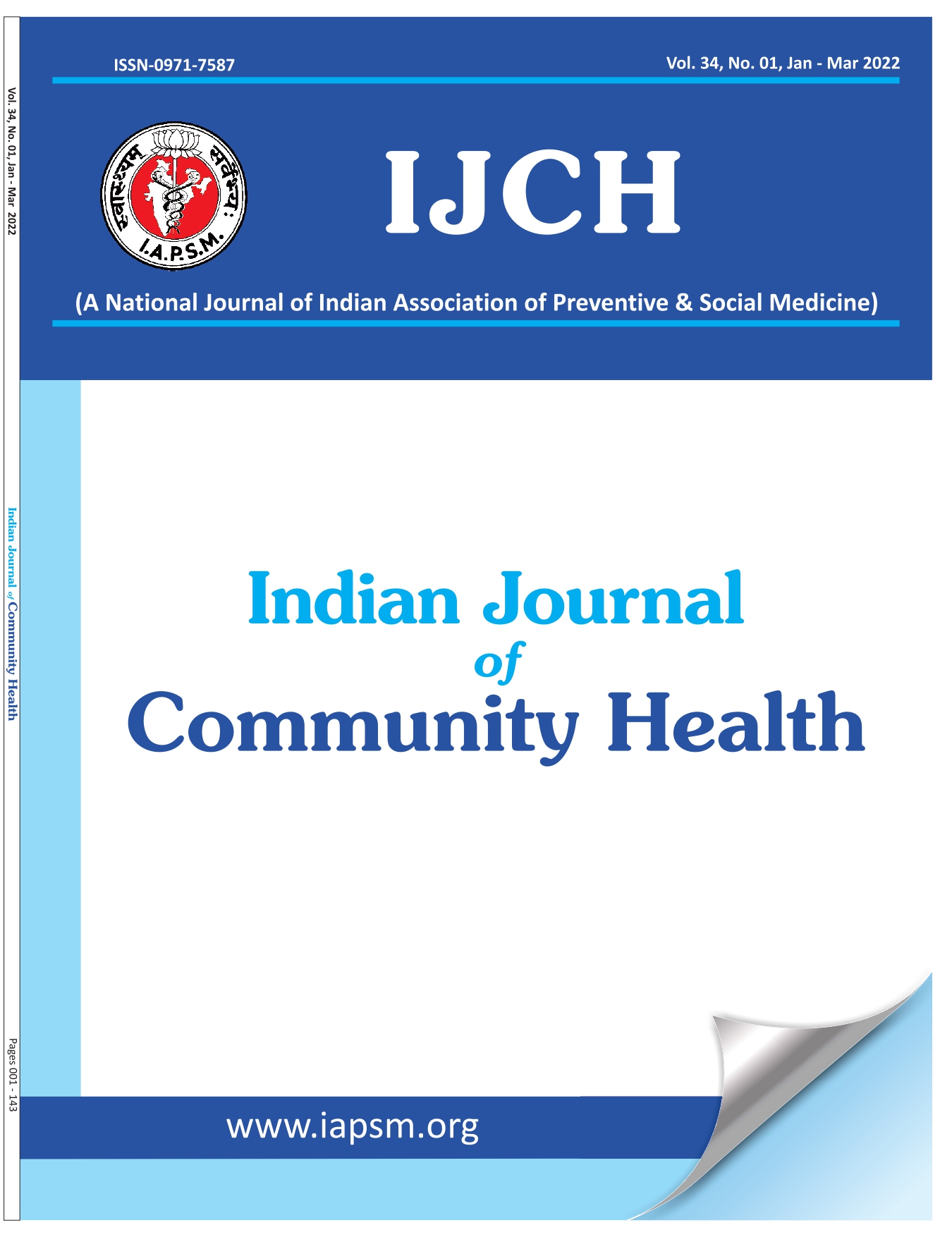An Epidemiological study of health behavioral and protective factors among school going adolescents (aged 13-17 years) of Ahmedabad, Gujarat using the Global School-based Student Health Survey (GSHS) questionnaire
DOI:
https://doi.org/10.47203/IJCH.2020.v32i01.007Keywords:
Adolescent, Health behavior, Protective factorsAbstract
Background: Adolescence is considered as the next unsurpassed stage of life to childhood targeting for preventive and health promotional activities. Encouraging these activities firstly requires identification of high-risk behaviors and protective factors prevalent among such adolescents during current epidemiological transition period. Objective: To estimate the prevalence of various health behavioral and protective factors among school going adolescents of Ahmedabad. Methodology: A cross sectional study was conducted among 403 school going adolescents of rural field practice areas of a medical institute using GSHS self-administered questionnaire -Indian version. Almost all aspects of the questionnaire such as dietary behaviors, hygiene, mental health, physical activity, protective factors, tobacco use, violence & unintentional injury, alcohol use and drug use were included in this study. Results: Out of a total of 403 students, 25.3% and 48.9% of students ate fruits and vegetables three or more times a day in past 30 days, respectively. About 41.2 % of students drank carbonated drinks on two or more times per day. Majority (77.7%) of the students brushed their teeth two times per day in past 30 days. Some 9.2% of students felt lonely in past 12 months and 8.4% of students had no close friends. Around 46.2% of students missed classes or school without permission in past 30 days. 30% of students remained physically active for all 7 days in last week. A few of students smoked cigarettes (2.5%) and used any form of tobacco (7.9%) on one or more days during past 30 days. The significant differences were found in many areas of risk behaviors as well as protective factors between boys and girls. Conclusion: Various unhealthy behaviors and protective factors were identified among school going adolescents from the present study. The difference was significant.
Downloads
References
Al-Sagarat AY, Al Kalaldeh MT., Prevalence of Health-risk Behaviors among Government Schools' Students in Jordan. Iran J Public Health. 2017 Dec;46(12):1669-1678.
Darfour-Oduro SA, Buchner DM, Andrade JE, Grigsby-Toussaint DS., A comparative study of fruit and vegetable consumption and physical activity among adolescents in 49 Low-and-Middle-Income Countries, Sci Rep. 2018 Jan 26;8(1):1623. doi: 10.1038/s41598-018-19956-0.,
Ranasinghe S, Ramesh S, Jacobsen KH.; Hygiene and mental health among middle school students in India and 11 other countries.; J Infect Public Health. 2016 Jul-Aug;9(4):429-35. doi: 10.1016/j.jiph.2015.11.007.
Centers for Disease Control and Prevention. Adverse childhood experiences study. Publications on major findings by health outcomes. Atlanta, GA: CDC; 2009. Available from: www.cdc.gov/nccdphp/ACE/outcomes.htm
Chartier MJ, Walker JR, Naimark B. Childhood abuse, adult health, and health care utilization: results from a representative community sample. Am J Epidemiol 2007;165: 1031-8. PMID:17309899 doi:10.1093/aje/kwk113.
World Health Organization, Global School-based Student Health survey (GSHS) –Non-communicable diseases and their risk factors, from https://www.who.int/ncds/surveillance/gshs/en/ last accessed on November 04, 2018.
Global School-based Student Health Survey, India (CBSE) 2007 Fact Sheet, accessed from http://www.who.int/ncds/surveillance/gshs/2007_India_CBSE_fact_sheet.pdf on November 03, 2018.
Siziya S, Muula A S & Rudatsikira E, Prevalence and correlates of truancy among adolescents in Swaziland: findings from the Global School-Based Health Survey; Child and Adolescent Psychiatry and Mental Health, 2007,1:15 https://doi.org/10.1186/1753-2000-1-15.
Badr HE, Lakha SF& Pennefather P, Differences in physical activity, eating habits and risk of obesity among Kuwaiti adolescent boys and girls: a population-based study, Int J Adolesc Med Health. 2017 Jun 17. pii: /j/ijamh.ahead-of-print/ijamh-2016-0138/ijamh-2016-0138.xml. doi: 10.1515/ijamh-2016-0138.
Al-Sagarat AY, Al Kalaldeh MT, Prevalence of Health-risk Behaviors among Government Schools' Students in Jordan; Iran J Public Health. 2017 Dec;46(12):1669-1678.
Qorbani M, Kelishadi R, Djalalinia S, Motlagh ME, Kasaeian A, Ardalan G, Shafiee G, Safari O, Heshmat R, BaradaranMahdavi S, Regional disparity in hygienic behaviors of Iranian children and adolescents: The CASPIAN-IV study; Med J Islam Repub Iran. 2016 Oct 18;30:431.
Darfour-Oduro SA, Buchner DM, Andrade JE, Grigsby-Toussaint DS, A comparative study of fruit and vegetable consumption and physical activity among adolescents in 49 Low-and-Middle-Income Countries; Sci Rep. 2018 Jan 26;8(1):1623. doi: 10.1038/s41598-018-19956-0.
MacGillivary H, Erickson G: Truancy in Denver: Prevalence, effects and interventions. 2006, National Centre for School Engagement, Denver, Colorado, Accessed 15 May 2007.[ http://www.schoolengagement.org/TruancypreventionRegistry/Admin/Resources/ Resources/108.pdf ]Google Scholar .]
Stanton B, Cole M, Galbraith J, Li X, Peddleton S, Cottrel L, Marshall S, Wu Y, Kaljee L: Randomized trial of a parent intervention: parents can make a difference in long-term adolescent risk behaviors, perceptions, and knowledge. Arch Pediatr Adolesc Med. 2004, 158: 947-55. 10.1001/archpedi.158.10.947.
Ranasinghe S, Ramesh S, Jacobsen KH; Hygiene and mental health among middle school students in India and 11 other countries, J Infect Public Health. 2016 Jul-Aug;9(4):429-35. doi: 10.1016/j.jiph.2015.11.007. Epub 2015 Dec 3.
Downloads
Published
How to Cite
License
Copyright (c) 2020 Indian Journal of Community Health

This work is licensed under a Creative Commons Attribution-NonCommercial-NoDerivatives 4.0 International License.





